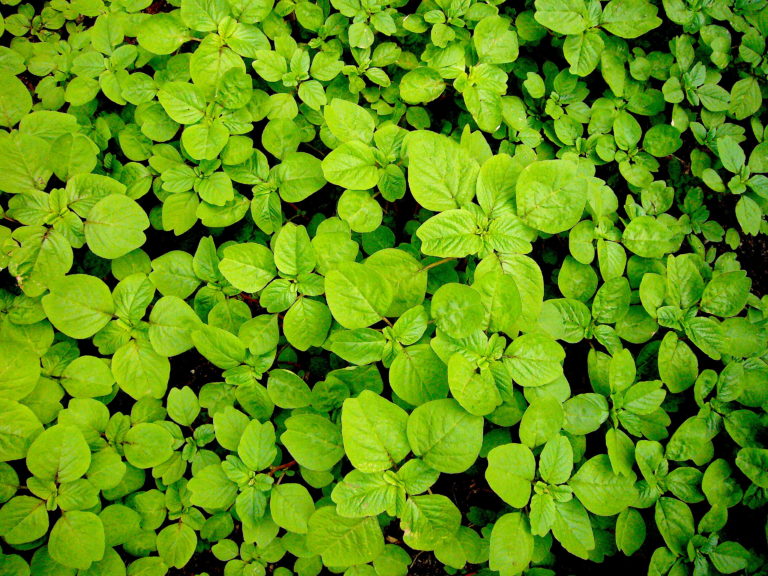
While parts of the country are experiencing foraging withdrawal our season is picking up with plants such as tender young amaranth, a spinach relative and very mild at this age. Note the leaves have end notches.
Fall usually means the end of the growing season and most harvesting for the year in northern climates. In the southern parts of the United States winter — as it is in many areas of the world — is a prime foraging time. Many annual northern plants that can’t grow the southern summer heat happily thrive here in winter. Many are sprouting early this year. Sunday I spied a foot-high sow thistle. Quite unusual this time of year. It would be a few more weeks before I would expect to see one that tall. Whether this means a longer season or just a season move ahead a few weeks will not be known until later this spring. I’ve already written about our winter Pellitory being up. Some is approaching a foot high, most unusual for now. And while Amaranth and Lambs Quarters are year round plants they favor the winter and spring. The little patch above was in disturbed mulch. I’ve also seen some good-sized rosettes of Poor Man’s Peppergrass and they were exceptionally hot. It’s a year round plant but usually one that also favors the spring, not the fall. There’s even a descent crop of fall elderberries which also usually favor the spring as well as Sheep’s Sorrel, definitely a winter green. Still waiting to be found this season are stinging nettles (Urticas) and chickweed (Stellaria.) They like it cool so don’t expect them until around Christmas or later but this year who knows.
Put five foragers in a room and you’ll have seven opinions on how to process acorns. It has been raining acorns for some several weeks. And if the noise from the tin roof of a near-by church is any indication they will be sprinkling for some time to come. The size of the acorn harvest — called a mast — is influenced by spring rains: More rain, more acorns in the fall. This pattern can be found locally, regionally, or nationally. As for processing (to remove the bitter tannins) the shelled, crushed acorns can be soak in cold water, or boiled for fast extraction, or treated with lye. There are advantages to and champions of all methods. You can read about them here.
Saturday’s foraging class in Sarasota perhaps saw the last gasp of our wild cucumbers for the season. Vines were producing heavily, as were the American Beautyberry. One hundred and forty nine miles to the northeast the little cukes are done for the year and most of the beautyberries have been harvested by the denizens of forest. The woodlands are their supermarket after all. Sunday’s class in Winter Park, just north of Orlando, produced two surprises. The first is some blooming yams, in this case Dioscorea alata, to the left. These plants usually reproduce vegetatively with “air potatoes” or by root sections. Every now and then they have inconspicuous flowers. The sun happened to hit them just right so a picture was in order for this rare event. We were in the thick of yam vines looking for the huge roots. This is exactly the time of year to start looking for the misshapen “air potatoes” of the D. alata because they are easy to spot for the next couple of months. They will help you find the vine and the big edible root it produces. The entire plant above ground disappears around Christmas leaving only the “air potatoes” on the ground to sprout around tax day.
The other surprise in Winter Park was a huge gourd about eight feet off the ground hanging in the trees. My first guess was a luffa, and it was a good one: Luffa aegyptiaca. I have grown luffa in the past so the shape was familiar to me. Usually luffa are eaten quite young, three to five inches long, and used like any small squash. When allowed to grow longer than become fibrous hence the luffa sponge, a natural scouring pad. In this case the luffa has a bit of a story to tell. It is not just a cultivated plant. This variety is naturalized in seven U.S. states and Puerto Rico. Those states are Florida, Texas, Louisiana, the Carolinas, Virginia and Illinois. Interestingly it is also cultivated in the United States for export to Japan. The vines can grow up to 24 feet and the fruit two feet long. It is also called a smooth luffa in that another variety is actually fluted. Not only only are they eaten or when older used for scrubbing but they can also be used as strainers and filters particularly for cleaning home pressed seed oil. The yellow blossoms are edible as well.
This is a reminder the Florida Herbal Conference 2014 will be held in Deland in late February, organized by Emily Ruff. Also for the third year in a row I will be leading weed walks at the herbal conference, a challenge in winter on dry ground. The walks are usually first thing in the morning when the air is cool and camp fires warm. Although it is the Florida Herbal Conference it draws teachers and students from all over North America. Two other Florida “locals” will be teaching classes besides the scheduled main speakers. They are Mycol Stevens of Gainesville, organizer of the Florida Earthskills gatherings — usually in early February — and Andy Firk who holds a wide variety of workshops throughout the year at his “Bamboo Cove” in Arcadia.
Though your foraging may drop off during the winter it’s a great time to study wild edibles with my nine DVD set. Each DVDs has 15 videos for 135 in all. They make a great Christmas gift. Order today. Some of these videos are of better quality than my free ones on the Internet. They are the same videos but many people like to have their own copy. I burn and compile the sets myself so if you have any issues I handle them personally. There are no middle foragers. And I’m working on adding a tenth DVD. To learn more about the DVDs or to order them click here.
A friend suggested I share this picture with you. It is of a much younger me and the reason why I intentionally moved south. After military service in warm southeast Asia I attended college. This was taken my wintery sophomore year. There might be a slight smile on the face but shoveling snow (and splitting winter wood) were never on the top of my list of necessary fun things to do. And while foraging is not impossible in the winter in Maine it is greener here in Florida. (By way of an explanation, I recently purchased a stand alone slide/film reader to copy several thousand slides and negatives. It converts them into image files. The device works very well, costs about $70, and I recommend it. It is a DB Tech Film Scanner. Mine is model FS150… no I don’t get a cut. It is just something that does well what is was designed to do. Two observations, though. Copying slides from film made in the 50s is a little tough because the film then was slightly larger than the later standardized 35mm. And I would have put the copy button in a different location. But those are minor grievances for a very fine product. )
To donate to the Green Deane Newsletter or Website click here.

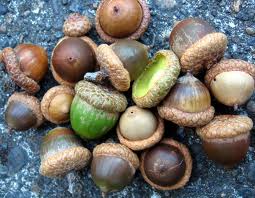
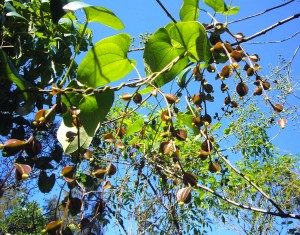
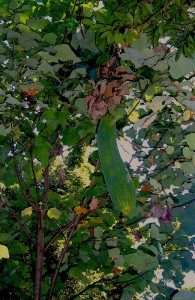


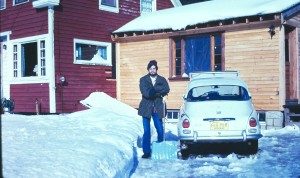

Thank you so much, I had almost forgotten the joys involved with snow removal at the family cabin on Big Bear Lake California. The ultimate horror was the knowledge that it needed to be done over and over again.
I spent the whole month of June in Brunswick, Maine. I found Curly Dock, Lamb’s quarters, Japaneese Knotweed, burdock, shepherd’s purse, early bunchberry, and the other usual suspects that I know of, but couldn’t find Indian Cucumber (I’ve never actually identified it yet). Also notable, it rained every day except one.
the last year I lived in coastal New England we had 13 noreasters in a single winter. The towns ran out of money to plow and I lived at the bottom of a hill (had to park at top of hill and walk up). I made my escape plans when the drift I was shoveling into or rather onto was over my head. I have been back only once in the winter in the last 25 years.
I lived a stint in Florida but I like the full four seasons so I have been all across the united states and found the smoky mountains of Tennessee to be the best place to settle not to much snow but enough to keep me from going back home to Massachusetts. Or Colorado where i lived for a few years. I walk out my door and all I see is wild food all around me love it here and your news letter thanks. I teach once in a while and write once in a while and may do it again sometime. Natty
isn’t that the same pair of glasses?!
just tried quandong (santalum acuminatum) kernels here in the nullarbor and they taste like fliberts
Thank you for the useful info in this issue and your article “Acorns: The Inside story” . My grandson ( Yusuf, a future forager) has kept some handfuls of acorns he has collected from nearby his dwelling in Southampton -UK with the purpose of gifting them to his friends in Khartoum -Sudan for which he intends to leave by next week. It is known that during the Norman conquest the English took with them dried acorns, as they had much belief that it might keep away the dangers they might face and thus used it as an emblem of luck, prosperity, youthfulness and power. It was also thought to bring good luck and highten the spirit. More over, I’ve noticed so much fascination by the people of the city of Southampton towards the “oak Tree” that you never miss the name touring around; examples like : Oak Tree Road, O,T,Lodge, O. T.Londis, O. T.Manor Place,..are but afew. Noteworthy, the emblem of Southampton’s Football Club bears distinctly the figure of the tree (oak) signifying nearby New Forest – with oak trees – and a river to show the maritime connections. It is seen the tree symbolizes life, strength, wisdom, nobility, family, loyalty,power, longevity, heritage, and honour.